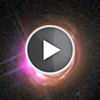CXC Home | Search | Help | Image Use Policy | Latest Images | Privacy | Accessibility | Glossary | Q&A
Tour of RX J1131-1231
Quicktime MPEG With closed-captions (at YouTube)
Black holes seem like such mysterious and complicated objects. On one hand, they are, and astronomers have been studying them for decades to learn more. On the other, black holes are actually quite simple. By this, we mean that black holes are defined by just two simple characteristics: their mass and their spin. While astronomers have long been able to measure black hole masses very effectively, determining their spins has been much more difficult. A new result from researchers using data from NASA's Chandra X-ray Observatory and ESA's XMM-Newton takes a step in addressing the spin question. By a lucky alignment, the light from a quasar some 6 billion light years has been magnified and amplified due to an effect called gravitational lensing. This allowed researchers to get detailed information about the amount of X-rays seen at different energies. This, in turn, gave the researchers information about how fast the supermassive black hole at the center of the quasar is spinning. When combined with the spins from other black holes using more indirect methods, astronomers are beginning to better understand just how black holes grow over time across the Universe.
[Runtime: 01:30]
Quicktime MPEG With closed-captions (at YouTube)
Black holes seem like such mysterious and complicated objects. On one hand, they are, and astronomers have been studying them for decades to learn more. On the other, black holes are actually quite simple. By this, we mean that black holes are defined by just two simple characteristics: their mass and their spin. While astronomers have long been able to measure black hole masses very effectively, determining their spins has been much more difficult. A new result from researchers using data from NASA's Chandra X-ray Observatory and ESA's XMM-Newton takes a step in addressing the spin question. By a lucky alignment, the light from a quasar some 6 billion light years has been magnified and amplified due to an effect called gravitational lensing. This allowed researchers to get detailed information about the amount of X-rays seen at different energies. This, in turn, gave the researchers information about how fast the supermassive black hole at the center of the quasar is spinning. When combined with the spins from other black holes using more indirect methods, astronomers are beginning to better understand just how black holes grow over time across the Universe.
[Runtime: 01:30]
(Credit: NASA/CXC/A. Hobart)
Return to RX J1131-1231 (March 5, 2014)



